Euro 2022 will be the very first major international finals that Northern Ireland have been represented at but life won’t be easy for them on arrival on the grand stage as they have been handed a tough draw in group A with tournament hosts and World Cup semi-finalists England, World Cup quarter-finalists Norway and Euro 2017 semi-finalists Austria to contend with.
Northern Ireland qualified via the play-offs having finished second in qualifying Group C behind Norway. The Irish finished the qualification group level on points with Wales and with a vastly inferior goal difference. However, due to the head-to-head away goals tie breaker, a 0-0 draw at home and a 2-2 draw in the reverse fixture proved enough for them to scrape into second place. Ashley Hutton’s 94th-minute headed equaliser in Newport turned out to be the decisive goal in clinching second place.
The side managed by Kenny Shiels entered the playoffs as the lowest-ranked second-placed team in qualifying (ninth out of nine) and were handed a favourable draw against the second lowest-ranked of the second-placed teams, Ukraine. Northern Ireland defeated them in both legs — 2-1 away before winning the return leg 2-0 — to seal a comfortable 4-1 win on aggregate.
Shiels’ side have come up against all three of their Group A opponents in qualifying for Euro 2022 and next year’s FIFA World Cup. When they met Norway, who topped their group in qualifying for this tournament, they lost 6-0 home and away. More recently, a 4-0 October defeat to England at Wembley was followed by a 5-0 thumping at home in April.
The matches against third-pot Austria represent Northern Ireland’s best chance of a win this summer. It took a 92nd-minute equaliser in October from the Austrians to snatch a 2-2 draw in Belfast, and Northern Ireland had chances in their 3-1 defeat in Austria.
Shiels took over the national team in May 2019 with them ranked 59th in the world and despite facing numerous injuries and setbacks, he has pulled off a remarkable feat in guiding them to their first finals. The former Kilmarnock Men’s team manager has been working on a full-time basis with 22 of his non-full-time Ireland-based players since January. He will be using the seven-month preparation period to bridge the gap with his side’s formidable opponents but making it beyond the group stage is a big ask of an already overachieving team.
This article will be a tactical analysis preview of Northern Ireland going into Euro 2022 in the form of a scout report. It will be an analysis of the side’s tactics under Shiels to predict how the Irish will set up in the upcoming tournament.
Predicted Starting XI
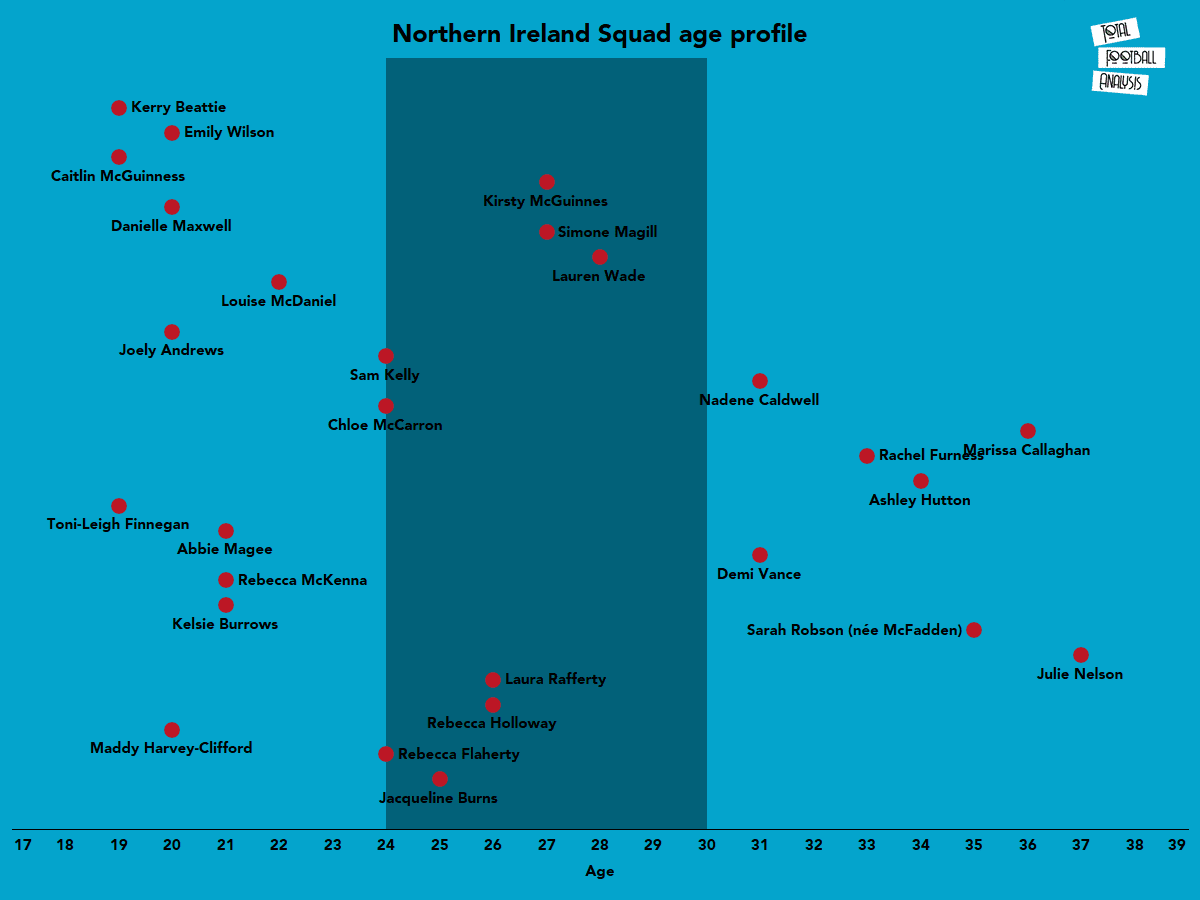
At the time of writing, Northern Ireland had not named an official squad for the tournament. This 28-player squad list is based on who’s likely to be picked for the final squad from the 22-player training camp and from those playing full-time in Scotland, England and the United States, who have been picked in previous squads.
This age profile chart divides the squad into three age brackets – young players (aged 24 and under), players in their peak (24 to 30) and experienced (aged 30 and over). As can be seen, the predicted squad has a good balance in terms of age and experience.
Nine players will be at their peak age for the tournament with around 11, depending on how many make Shiels’ final selection, young players. These young players may inject some valuable energy during a tournament with short turnarounds between matches.
Northern Ireland have seven players on the experienced edge of the scale, five of whom are 33 or over. With qualification for next year’s World Cup looking very unlikely, several players will no doubt be making their final appearances for their country at this summer’s tournament.
Goalkeeper Jacqueline Burns, defenders Rebecca Holloway, Laura Rafferty, Sarah Robson (née McFadden), Demi Vance, midfielder Rachel Furness and forwards Simone Magill and Kerry Beattie, who are all full-time professionals, are likely to join up with those selected from the training camp.
Glentoran centre forward Casey Howe is unlikely to be included. The 19-year-old has had a strong start to the domestic season, but being omitted from the seven-month training camp appeared to have ended her hopes of being involved.
Rangers’ Megan Bell and Glentoran’s Caragh Hamilton, two would-be regulars, are also set to miss out. The midfielders have picked up long-term injuries which have cruelly ruled them both out of the tournament.
However, Ashley Hutton has returned to action for Linfield after 10 months out with a cruciate ligament injury. Should the centre-back’s recovery stay on track, there’s little doubt Shiels will select her. Her 111 caps could provide invaluable experience to the group.
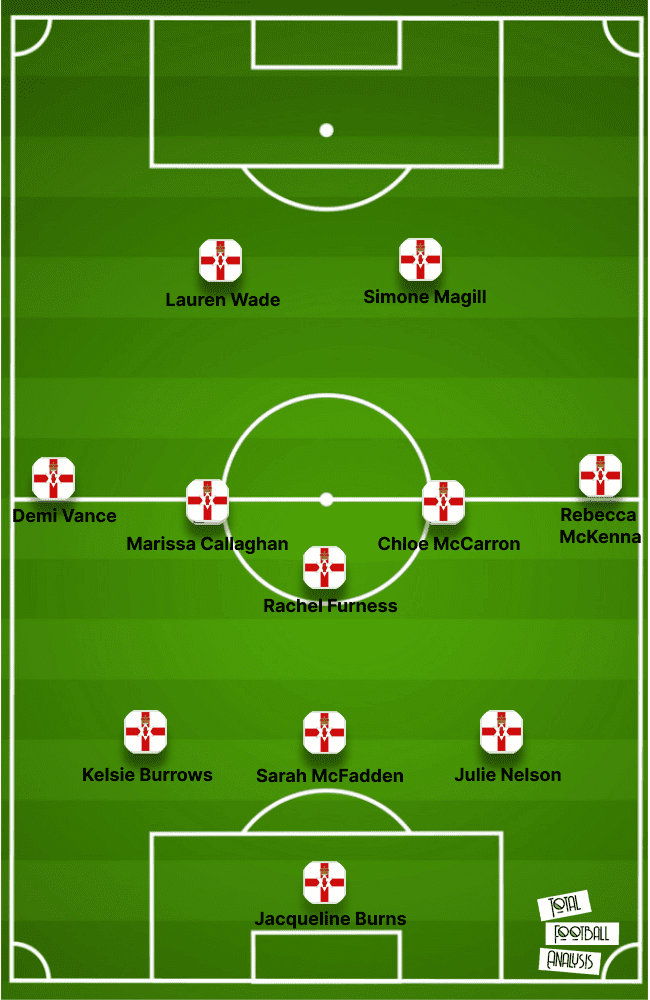
Given the quality of the opposition and how Shiels has set his team out before, it is expected that he will use a 3-5-2/5-3-2 in at least two of the group stage matches. This is a system they have used against each of their Euro 2022 opponents in the past.
Jacqueline Burns, who plies her trade in the Swedish Damallsvenskan for BK Häcken, is Northern Ireland’s first-choice goalkeeper. The 18-cap stopper is good with her feet and is comfortable joining in the build-up play. Often positioning herself as an auxiliary centre-back, she can join in the build-up play closer to the halfway line than her box.
The back-five is packed with experience with Demi Vance (31), Sarah McFadden (35) and Julie Nelson (37). Plus, the possible addition of Hutton (34) gives the team plenty of experience to fall back on. Abbey Magee, who plays for Linfield, also has a good chance of a starting spot at right wing-back having started last time out against England.
The central midfield area is one of the stronger areas of the team with captain Marissa Callaghan, Liverpool’s Rachel Furness, and Glentoran’s Chloe McCarron all providing decent options. The 20-year-old Joely Andrews could also start having played a part in recent matches versus England and Austria.
Lauren Wade and Simone Magill appear to be Shiels’ favoured pairing when playing with a front two. The experienced pair work well alongside each other up front both in and out of possession. Kerry Beattie, who was the top scorer in the Northern Irish Premiership last season and has been in top goalscoring form for her new club side Glasgow City this season, is likely to feature from the bench.
Shiels likes to utilise his squad and has used the maximum of five substitutions in seven of his last eight competitive matches. He usually changes most of his front five, all of whom have to work extremely hard in the 3-5-2/5-3-2 system. This will give plenty of opportunities for his other attacking players to impress coming off the bench.
Attacking Phase
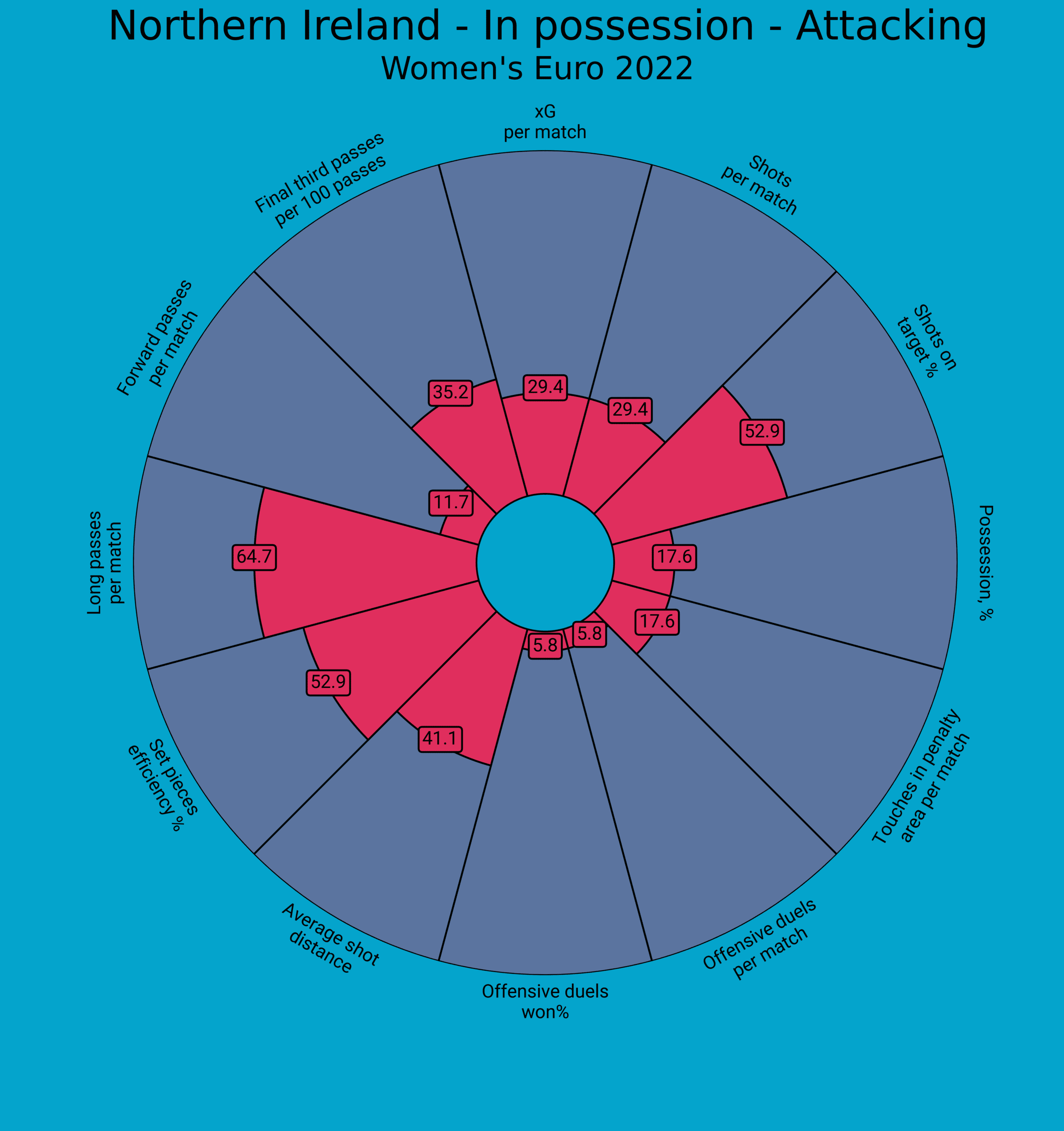
The above graphic shows attacking statistics from the previous calendar year in relation to the other teams that have qualified for Euro 2022. Northern Ireland are ranked in the 17.6 percentile for possession. This indicates they can expect to spend the vast majority of their time without the ball this summer. This was clear in their home meeting with Austria where they averaged just 37.51% possession; they saw that drop to 27% against England.
Northern Ireland’s xG per match also places them in the bottom third of teams participating in the finals. In their two recent matches against the Lionesses, Northern Ireland produced a goalscoring output of 0.09 xG at home and 0 xG in London. With those figures, Northern Ireland would expect to score just one goal for every 11 times they face England.
The three goals Northern Irelands have scored against Austria and most of their chances created against their group stage opponents have come from set-plays and counterattacks, which will be covered in the transitions section. With the likelihood they will be pressed high, this section is going to focus on how they will overcome the high press and create goalscoring opportunities.
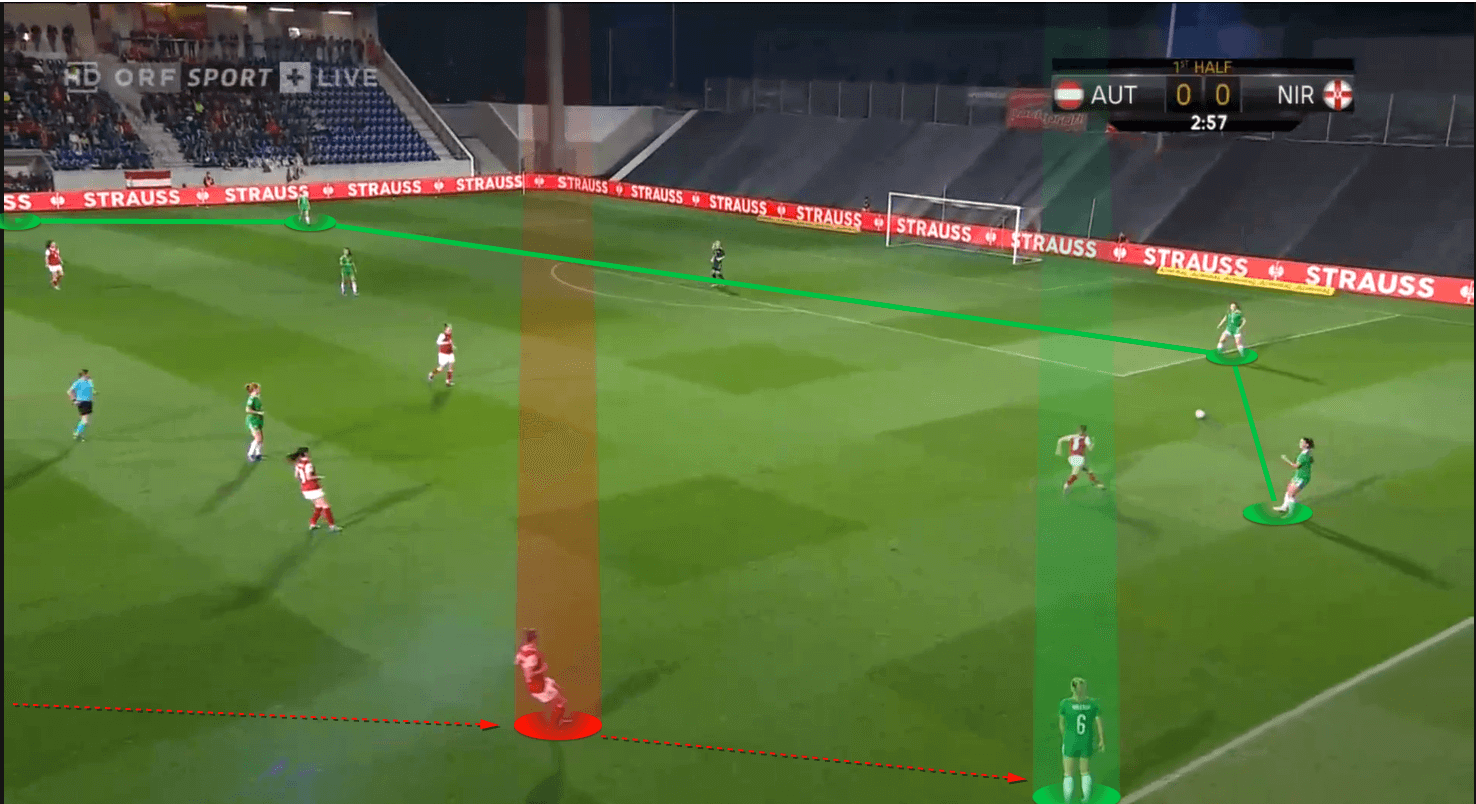
When playing out from the back, Northern Ireland play short passes in the build-up phase to encourage the opposition to press before exploiting the space behind them. Often, this is done by playing as few as one or two passes in their defensive third before playing a long ball in behind the opposition back-line.
Against Austria away, there was a clear game plan to target the area behind Austria’s full-backs who pressed aggressively and high up the pitch. To encourage the full-backs to press high, Northern Ireland, who were in a 4-3-3 at the time, had their forwards play low when the ball was on their side of the pitch.
The centre-forward occupied the two centre-backs, preventing them from shifting across to cover for their full-back. This created a large area of space for the goalkeeper or defenders to target with a long ball.

This image shows the left-forward in a low position just after her left-back had the ball. The left-back passed the ball into the feet of the centre-forward who had dropped deep to receive it. As the centre-forward picked up the ball, a central midfielder, on the blindside of the opposition midfield, made a run in behind the opposition right-back and right centre-back who had both been dragged out of position.
The Irish had several variations of movements and used different personnel to exploit the space they had created. The wide-forward herself would spin into the space and, when the ball was in wide areas, the ball would be played into the channel for the centre forward to chase down.
Even when no goalscoring opportunities came of it, it was a good way to relieve pressure and get the team higher up the pitch. There have, however, been times that the longer passes have been under-hit, resulting in a turnover of possession inside Northern Ireland’s half. Due to the spread-out positioning of the players, they can be left vulnerable in these situations.
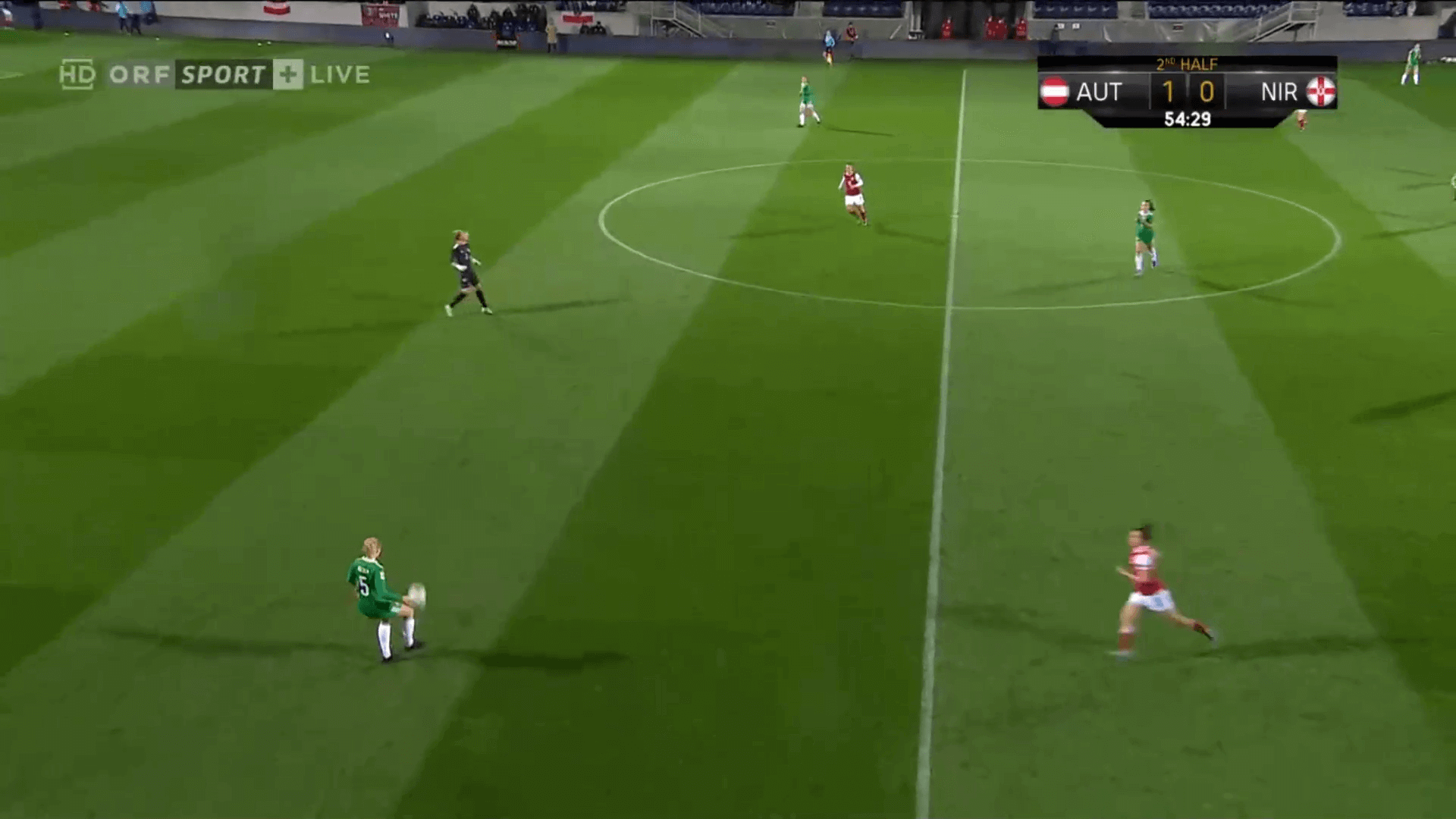
When the opposition drops off into a mid-block, Northern Ireland’s goalkeeper, Burns, has turned into an extra centre-back in the build-up phase. By positioning herself between the centre-backs in a 4-3-3, she allowed the centre-backs to split wider and the full-backs to push higher up the pitch.
The full-backs, being in more advanced positions, meant the front three could play closer together on top of the opposition centre-backs. This created a front five on the opposition back-line.
Whilst this did cause problems, with Austria being overloaded all over the pitch, the risks of this structure are obvious. Indeed, after having a spell on top where they should have equalised, it was from this scenario that possession was given away and Austria scored their second goal. A sloppy pass from the centre-back to the goalkeeper was intercepted by the forward who went on to score and ended Northern Ireland’s chances in the match.
Defensive Phase
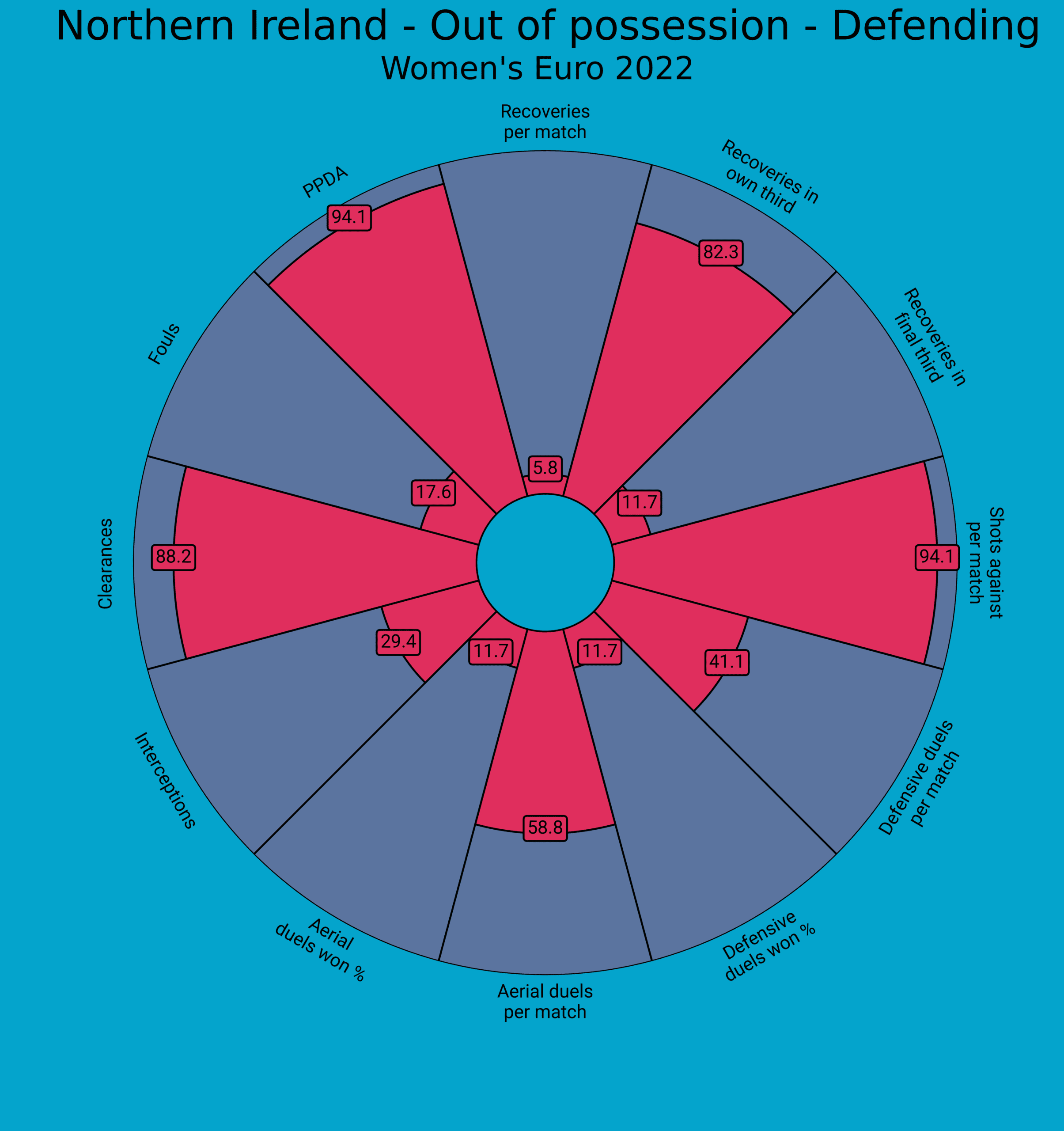
Against all their Group A opponents, Northern Ireland have spent, and will expect to spend again this summer, most of the match without the ball. As their PPDA percentile of 94.1 suggests, Shiels is content for his side to allow the opposition comfortable possession in certain areas of the pitch. This is underlined by their ranking in the 11.7th percentile for recoveries in their final third and 82.3 in their own third.
This is, of course, due to the set-up of the team, but, as will be covered in the transitions section, they are aggressive in stepping up to players and intercepting the ball in these areas.
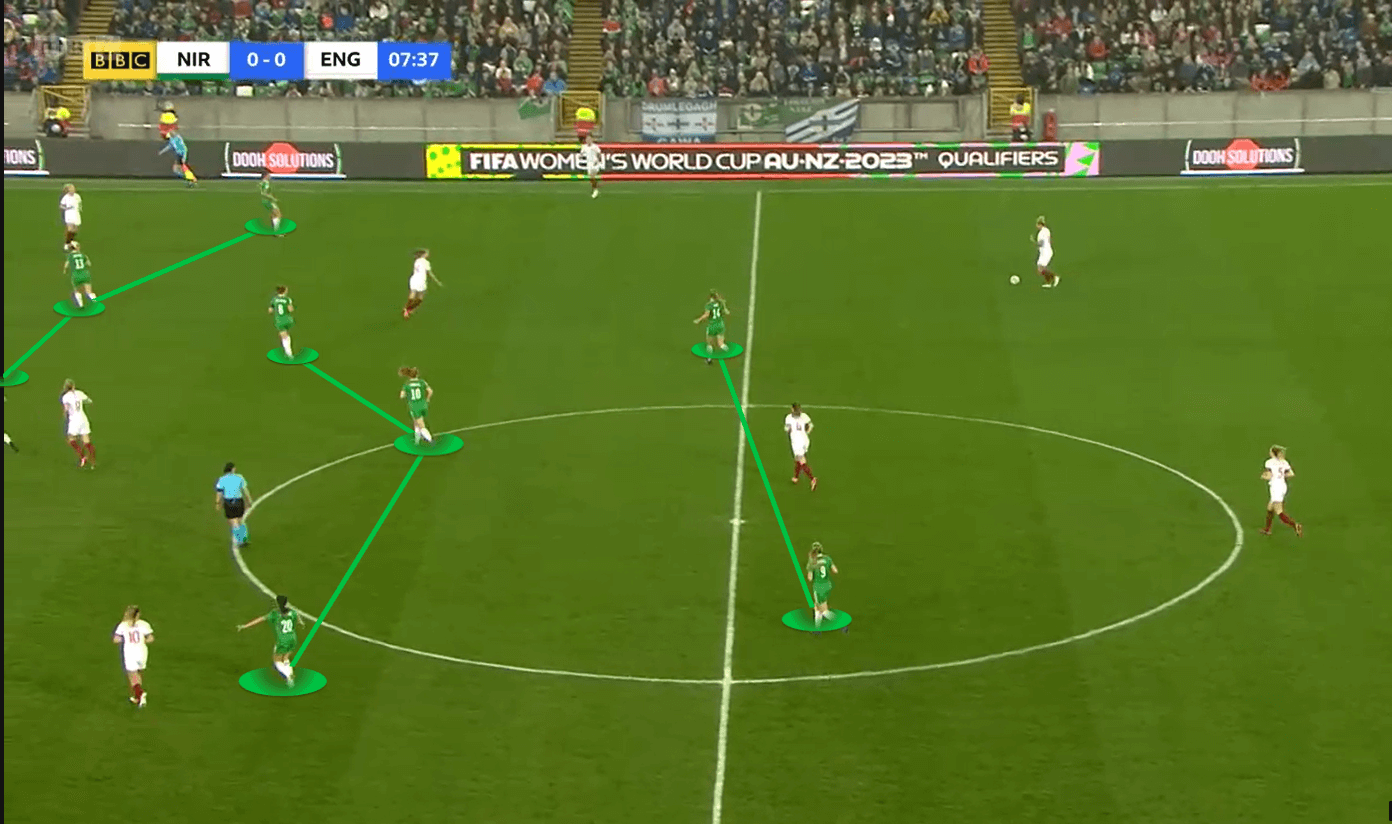
Northern Ireland defend in a 5-3-2 mid-block, allowing the opposition to have the ball in their half. The midfield and forwards play close to one another, crowding the midfield, whilst leaving the wide areas largely unoccupied. The back-five remains as a unit with any of them rarely pressing more than 10 yards ahead of their defensive line.
One of the two forwards presses the opposition’s centre-backs whilst the other marks the opposition’s deepest midfield player. Should the centre back pass to her defensive partner, the forward on the DMC presses the ball with the other taking over marking the DMC.
When the ball is central, the DMC, number ‘10’ Furness, plays more advanced than her two central midfielders. This allows her to press the opposition’s DMC when either of her forwards is not close enough to the DMC to prevent her from getting on the ball. When the ball goes into the wide areas, Furness drops behind her central midfielders into a more traditional DMC position.
The back five are positioned close enough to their midfielders to deny space for the opposition forwards to drop into and receive the ball. They are also deep enough that they are well-positioned to deal with any long balls over the top. The wing-backs mark the opposition wide-forwards and do not usually press the opposition’s full-backs unless they receive the ball very high up the pitch.
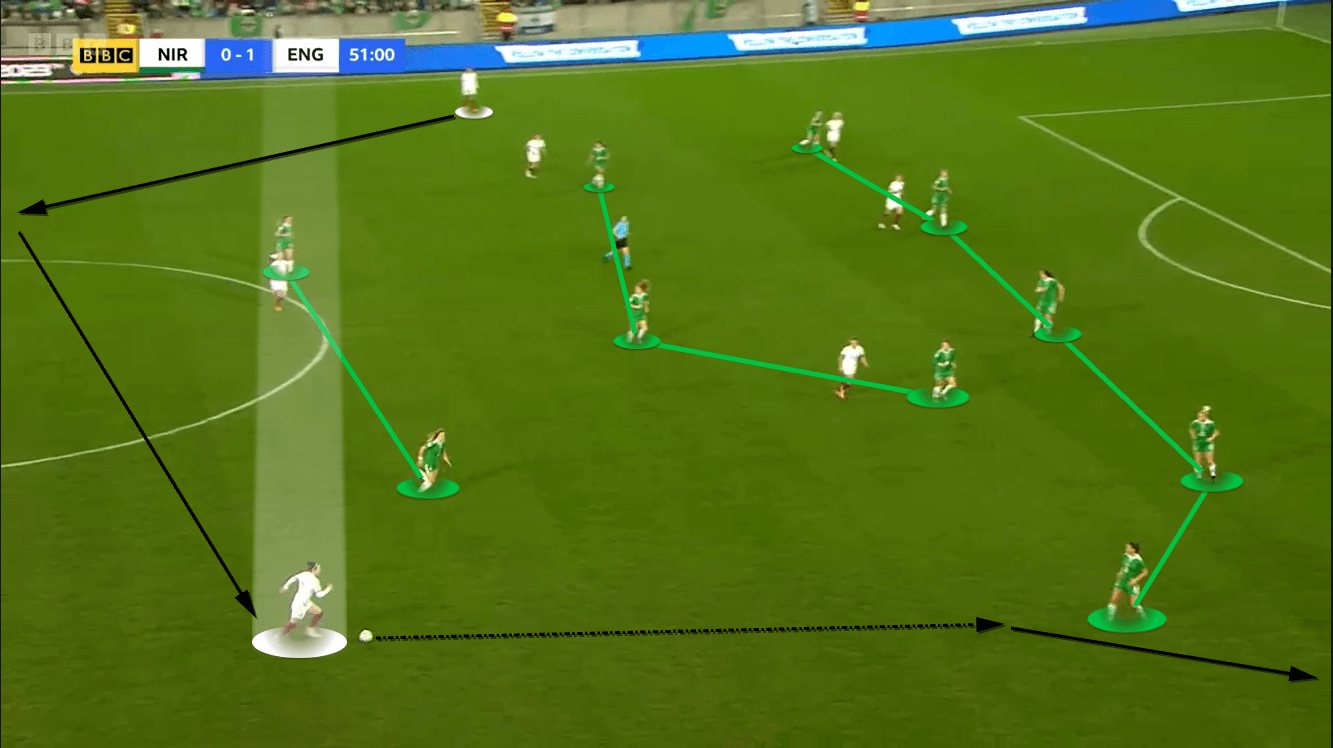
When the ball goes into the wide areas just inside Northern Ireland’s half, the front five overload that side of the pitch. If the forwards are close enough, one will press the ball. If not, then the closest midfielder will, with Furness offering security behind her. Should the ball be progressed down the same side, Northern Ireland are still comfortable. The back five has not been stretched and the three centre-backs, who all remain central, are generally good at dealing with crosses into the box.
The main issue, shown in the tactical image, is when they allow the opposition to switch the ball out of one wide area. With the front five so condensed on one side, it is very difficult for them to cover the distance required to press the opposite full-back. With the wingback being pinned by the opposition’s wide forward on her outside, she is unable to step up to the opposition full-back on the ball.
In this scenario, the fullback progressed 40 yards with the ball at her feet before being engaged. At that point, she combined with her wide-forward and then provided the cutback for a goal. Although a clear deficiency in the system, Shiels will feel the shape still provided more than enough bodies in the goal area when the ball entered the box to deal with the situation.
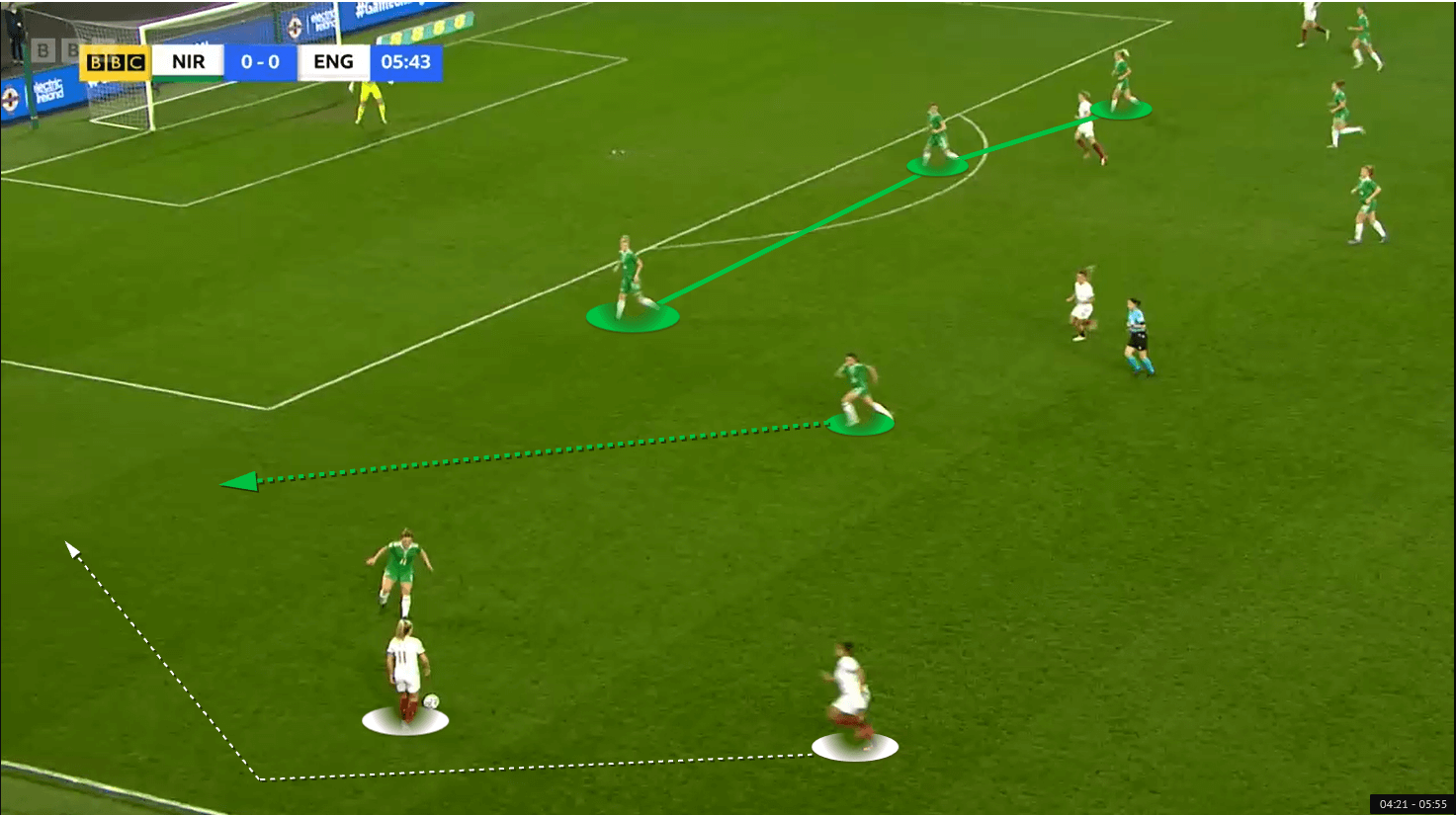
When the opposition has the ball in deeper areas, in and around Northern Ireland’s box, the midfield condenses the central area and forces the ball into wide areas. When the ball enters the wide area, the ball-near wing-back closes the player on the ball down quickly.
When the wingback presses, her centre-backs remain central which creates a gap between the wing-back and side centre-back. If the opposition has an overlapping full-back trying to exploit this gap, the ball-near central midfielder drops between her wing-back and centre-back to cover the run.
This allows the three centre-backs to remain central and stay well-positioned to deal with any cross into the box.
This overlapping movement was used as a decoy by England to empty the area in front of the centre-backs in the middle of the pitch. When the wide forward received the ball, she cut inside as her full-back was overlapping. From here, the wide forward combined with her forwards at the edge of the box. This caused a centre-back to jump to the ball which left space in behind for the wide-forward to receive.
Transitions
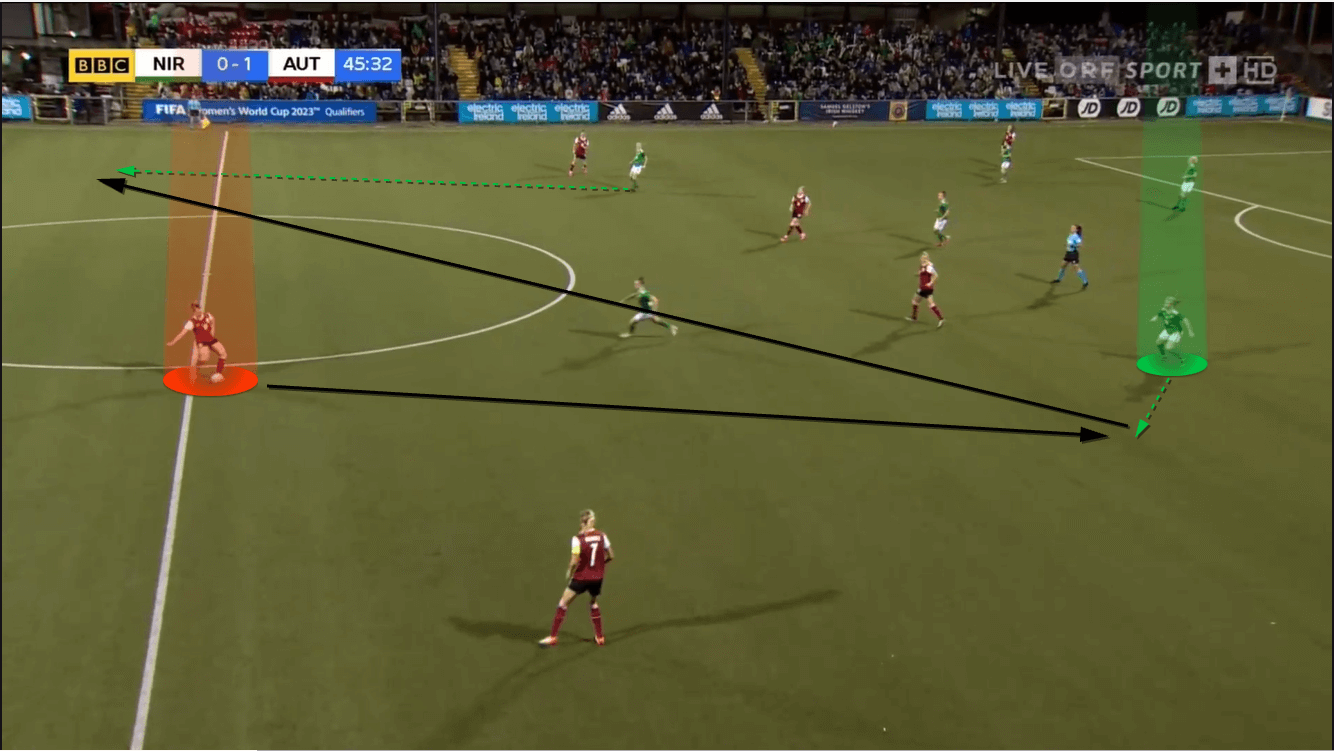
Given the quality of the opposition and Northern Ireland’s expected set-up, it is likely, along with set-plays, that counterattacks represent their best opportunity to score. Spending large spells of their matches without the ball, in a mid to low block and with the bulk of their turnovers occurring in their defensive third, these attacks will emerge from deeper areas.
This image shows a typical counterattack from their low-block which resulted in a goal in their home meeting with Austria. When in their compact defensive unit, they are aggressive in stepping forward to intercept passes. When the ball is intercepted, they play forward immediately and look to hit in behind at the first possible opportunity.
Here, Furness intercepts a ball intended for the opposition’s centre forward. After taking two quick touches, the ball is sent in behind Austria’s high backline — the wide-forward subsequently runs onto the pass and scores.
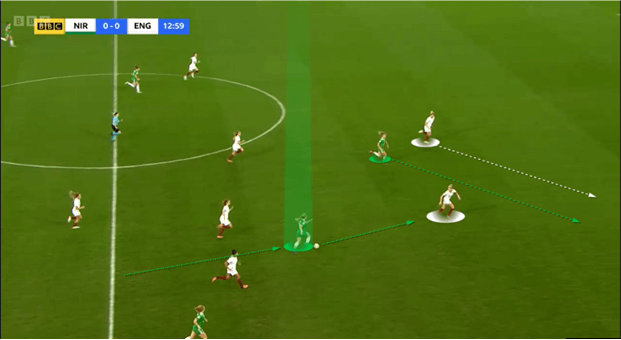
On other occasions, Northern Ireland, whilst still going forward immediately, will dribble forward with the ball instead of passing or playing long straight away. This attack originated from inside their box. A sliding interception was turned into a pass to Furness, who calmly dribbled out of the opposition’s counter-press before finding a pass into her forwards feet.
The forward turned with the ball and drove at the nearest opposition centre-back, pinning her in place, whilst her teammate made a diagonal run in behind the ball-near centre-back. This dragged the ball-far centre-back out of the central area leaving space for the advancing forward to attack with the ball. A major benefit of Shiels’ system including two central forwards is they can work together in these situations instead of one striker being isolated.
Northern Ireland look most dangerous from counterattacks, especially against the top teams when they dribble out of pressure. Although they scored against Austria from a long ball, they are overall too wasteful with these hopeful passes and fail to take the opportunity to at least relieve the pressure on their defence.
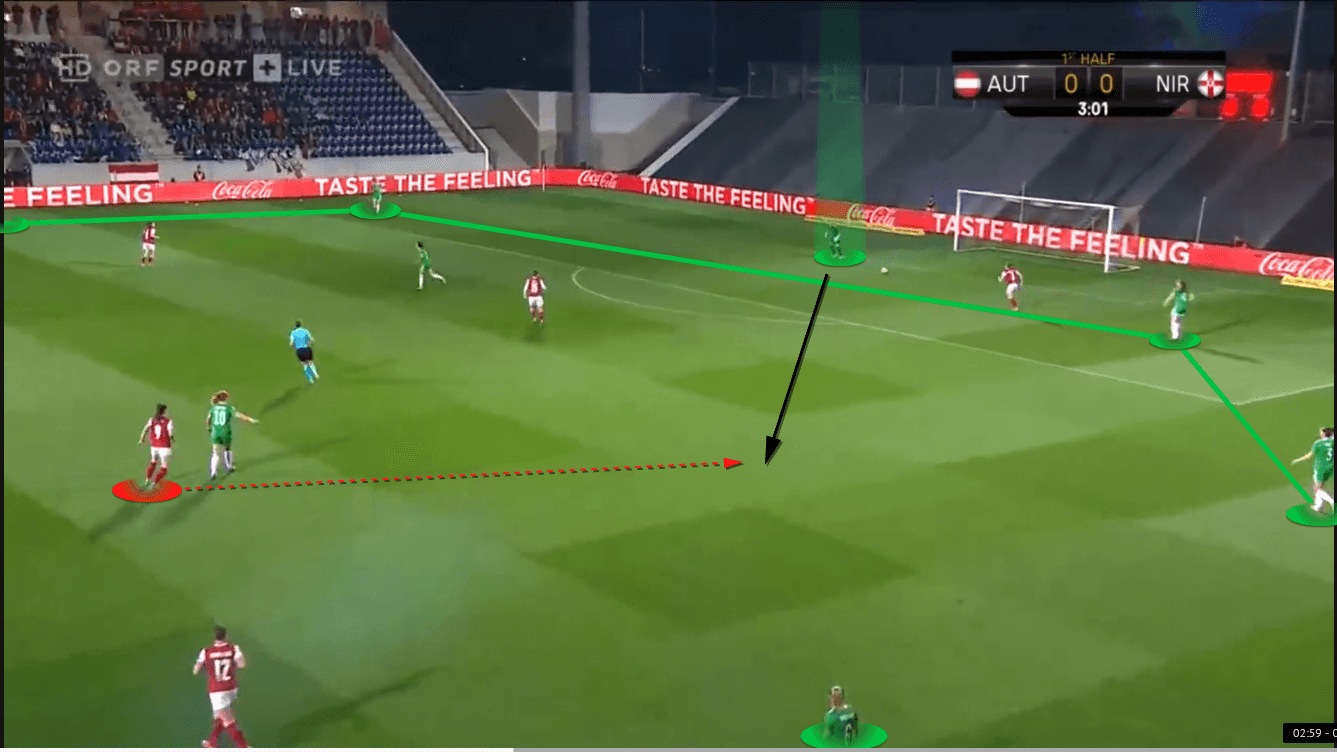
During the build-up phase, Northern Ireland are very expansive which leaves big gaps between players. Although generally, they look comfortable playing out from the back, there are times, usually when they try to play long, that they allow the opposition to intercept the ball.
This image shows Burns trying to play long to her forward after a couple of short passes around the back. The opposition central midfielder reads the under-hit pass and intercepts it. At the point of interception, the midfielder has a clear path towards goal and, at the very least, a clear chance to score looks inevitable.
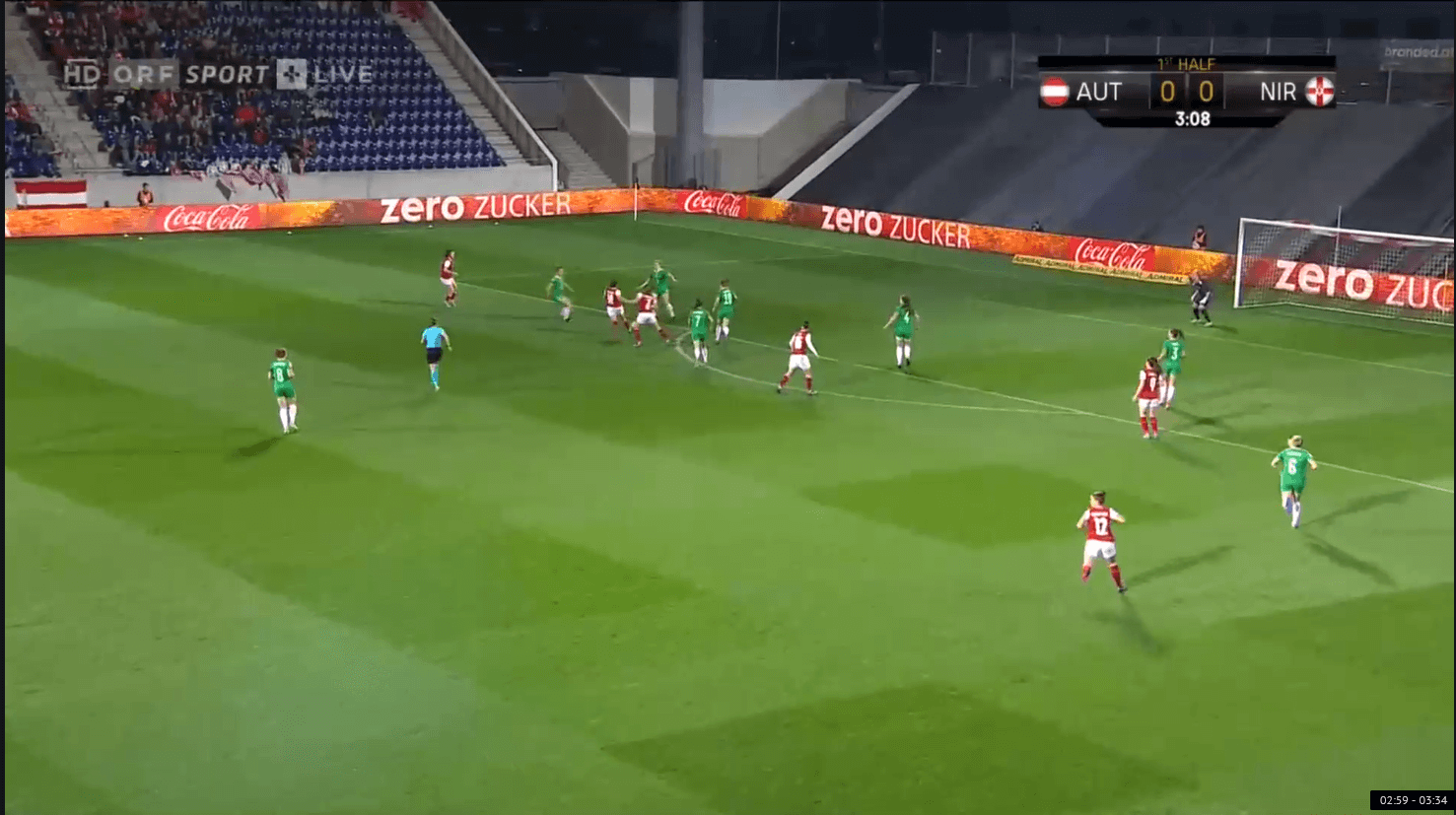
Within five seconds, the backline has very quickly reorganised itself between the ball and the goal, the midfielders have applied pressure to the ball and the danger has been completely smothered.
Northern Ireland’s immediate reaction to defensive transitions is clearly something they work on. Although a more clinical team may punish them in these situations, something that happens far too often, the reaction to getting players back behind the ball and defending the goal is impressive.
Defenders
Northern Ireland’s defence is a well-organised unit full of players who are now well used to lining up next to one another. They fit perfectly into Shiels’ style of play by being able to play out from the back as well as sit-back and defend crosses and long balls.
They are also capable of defending on the front foot, stepping out to prevent forwards from turning, and intercepting and launching counterattacks from deep areas. One of their more effective outlets for counterattacks is the left wing-back, Demi Vance, who is a powerful runner with the ball at her feet and can carry the ball long distances.
Shiels’ main concern about his backline will be the way England’s forwards were able to pull them so easily out of position and get in behind the wingbacks. Northern Ireland’s success against their neighbouring rivals may come down to how well their wingbacks defend in one-on-one situations.
Midfielders
Shiels’ midfield in each match will no doubt contain captain Callaghan and key player Furness, with McCarron, Andrews and Caldwell rotating for the third spot. The rotation of the midfield may well prove vital throughout their three group matches with the amount of running their playing system demands of them.
The midfield is expected to press the entire width of the pitch at times to allow their wingback to remain connected with the centre-backs. They also close down the opposition’s deepest central midfielder and fill gaps between their backline. In possession, they must be willing to make runs beyond the opposition’s defenders as well as supporting counterattacks.
Forwards
As with their midfielders, Northern Ireland’s front two are required to do a lot of running, especially during the pressing phase, and will therefore need to be rotated both within and between matches. Fatigue was evident as early as the 60th minute of their match against England as the front 2 were dragged to one side of the pitch and didn’t have the energy to chase the ball back across. This allowed England’s centre-back to step out of the back with the ball at her feet and play a through ball to her wide forward who went on to finish.
It was Kirsty McGuiness who came on against England to inject some much-needed energy after the starting two had begun to tire and she’ll no doubt be well utilised at the finals. Holloway and Sam Kelly are two others that we can expect to see lead the line at some point. The forwards will perhaps be judged more on how well they press rather than goals scored as their goalscoring opportunities are going to be at a premium.
Best Performer
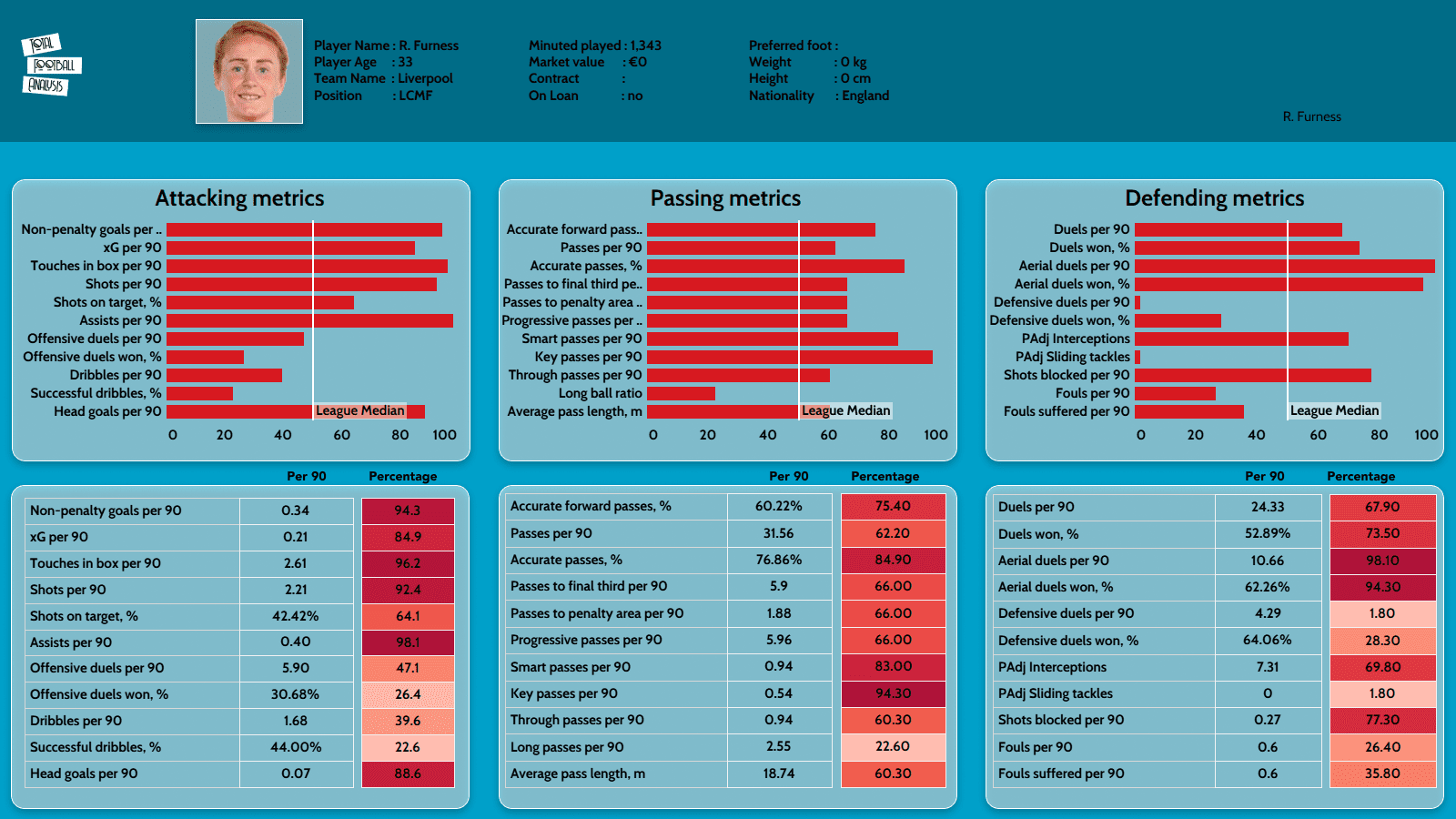
Northern Ireland’s number ‘10’ Rachel Furness has scored 38 international goals from midfield in 81 appearances and is the country’s all-time top goal scorer. The Liverpool playmaker played a part in her club’s promotion back to the FAWSL for next season, as they won the 2021-21 FA Women’s Championship. Born and raised in Sunderland, England, Furness chose to represent Northern Ireland after being denied the chance of a trial for England.
As the graphic illustrates, Furness outperforms the league median in almost all metrics when playing for her club side. The 33-year-old plays a similar role for club and country and can be described as a box-to-box midfield player. As her stats back up, she can both defend and attack at a high level.
For a midfield player, Furness’s international goals record is exceptional — she can score all types of goals. As well as finishing from outside the box and arriving late in the box to get on the end of crosses, she is a real threat from set plays. The Mak’em has scored four goals for club and country this season by getting on the end of set-play crosses, including a bullet header which came against Luxembourg.
In addition to scoring goals, the all-rounder in midfield has made 0.40 assists per 90 minutes. She has assisted nine goals this season, including a typically clever through ball for Northern Ireland’s opener against Macedonia last November.
During the build-up phase, Furness is often the player that picks the ball up from the centre-backs and launches attacks. She is comfortable both passing the ball out from the back and carrying the ball forward. She often receives the ball in tight areas and is able to dribble past the first line of pressure before finding a teammate.
Although defensive duels are not her strong point, she is capable of getting stuck in and putting a strong tackle in when necessary. She is also good at using her upper body strength to hold off opponents and retain possession.
Tournament Prediction
Northern Ireland’s best chance of winning a match at the tournament clearly comes against Austria. They have run them close in their two recent meetings and will feel they should have got more out of both recent matches. Away from home, the Irish were on top and had two opportunities to equalise with the score at 0-1. At home, victory was cruelly snatched away from them by a 92nd-minute Stefanie Enzinger header.
A victory against either of the powerhouses of England or Norway would surely go down as one of the finest in Northern Irish football history. Shiels will be hoping the derby feel of a tie against England may inspire the Irish to the game of their lives. They also have the added advantage of playing all their games at one venue, St Mary’s Stadium in Southampton. Perhaps the ground will begin to feel like home by the time they face The Lionesses in their third game on July 15th.
Shiels being able to work with much of the group on a full-time basis helps their cause. However, the country’s route to the finals — being the lowest-ranked side in the competition — and recent results against their direct opponents suggest that anything other than fourth place in the group would be a real achievement for the Green and White Army.






Comments